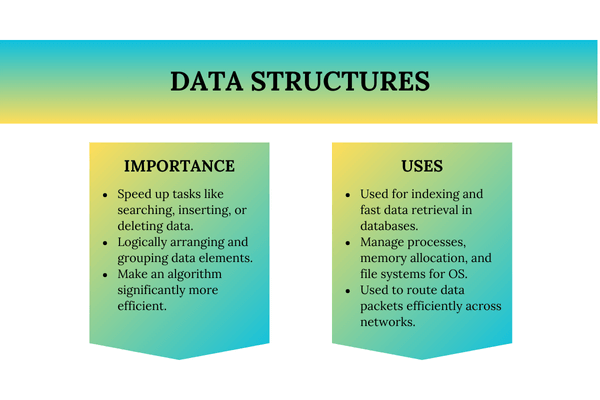Importance and Uses of Data Structures shape every modern application. From streaming platforms to self-driving cars, picking the right structure decides how swiftly data moves, how little memory it claims, and how satisfied your users feel.
Table of Contents
Why the Importance and Uses of Data Structures Matter
Efficient access, minimal latency, and predictable scaling all depend on good structures. A clever hash table can cut response times from seconds to microseconds, while a wrong choice can push cloud costs through the roof.
1. Speed That Delights Users
Algorithms ride on data structures. Binary search trees, tries, or B-trees turn million-row scans into millisecond look-ups—crucial when shoppers expect instant results.
2. Memory That Saves Money
Compact arrays or bitsets squeeze billions of values into RAM, slashing server bills. Meanwhile, lazy linked lists let you stream huge logs without loading everything at once.

Key Importance and Uses of Data Structures in Today’s Stack
Databases & Indexing
B-trees, skip lists, and LSM-trees power engines like MySQL, Cassandra, and modern vector databases. They juggle inserts, deletes, and nearest-neighbor queries for AI search.
Operating Systems
Priority queues schedule threads, while balanced trees manage virtual memory. Even your file explorer relies on DAGs to deduplicate blocks.
Artificial Intelligence
Graphs store knowledge for reasoning, tensors wrap arrays for deep learning, and KD-trees accelerate similarity search in recommendation systems.
Common Structures & Practical Examples
Arrays
Perfect for CPU-cache friendliness. Use dynamic arrays (e.g., std::vector) when you need fast random access—think image pixels or game entity lists.
Linked Lists
Great when inserts spread across a timeline, such as undo-redo stacks in editors. They shine in real-time logging where order matters more than indexing.
Stacks & Queues
Function-call stacks prevent crashes by tracking execution; message queues smooth bursty traffic in microservices pipelines.
Trees
Red-black trees keep dictionaries balanced in Java’s HashMap. Trie structures fuel autocomplete, while Merkle trees secure blockchain integrity.
Hash Tables
The go-to for caches, symbol tables, and DNS. Constant-time lookup means your browser finds a hostname before users notice the delay.
Modern Trends Elevating the Importance and Uses of Data Structures
- Persistent Data Structures – Functional languages preserve history without copying entire datasets.
- Lock-free Concurrent Structures – Compare-and-swap queues boost multi-core throughput.
- GPU-Optimized Structures – Space-filling curves index spatial data for AR/VR in real time.
- Vector Databases – Specialized indexes like HNSW enable lightning-fast semantic search for generative-AI apps.
- Cache-Aware Layouts – SOA (Structure of Arrays) beats AOS (Array of Structures) in data-oriented C++ game engines.
Choosing the Right Structure
- Profile Your Operations – Count reads, writes, and deletions.
- Mind the Hardware – SSDs prefer sequential writes; RAM loves locality.
- Think Parallel – Select structures with safe concurrent variants.
- Plan for Growth – Rebalancing costs can cripple at scale.
Use decision tables or flowcharts early; a quick diagram often prevents months of refactoring.
Frequently Asked Questions – Importance and Uses of Data Structures
Q1. Which data structure offers the fastest search?
For exact keys, a hash table yields average O(1) time; for ordered data, a balanced binary search tree provides O(log n) with sorted traversal.
Q2. How do I pick between an array and a linked list?
Choose arrays for constant-time indexing and cache locality; pick linked lists when you prioritize frequent inserts or deletions in arbitrary positions.
Q3. Are advanced structures worth learning for interviews?
Absolutely. Employers test heaps, tries, and graphs to gauge problem-solving depth. Mastering them boosts confidence and salary prospects.
Q4. What new data structures emerged recently?
Hierarchical Navigable Small World (HNSW) graphs power vector similarity search, while adaptive radix trees speed key-value stores like Redis.
Final Thoughts
The Importance and Uses of Data Structures cannot be overstated. Whether you’re optimizing cloud bills, delighting gamers with silky frame rates, or building the next AI breakthrough, the right structure is your secret advantage. Master them today, and your code—and career—will scale tomorrow.